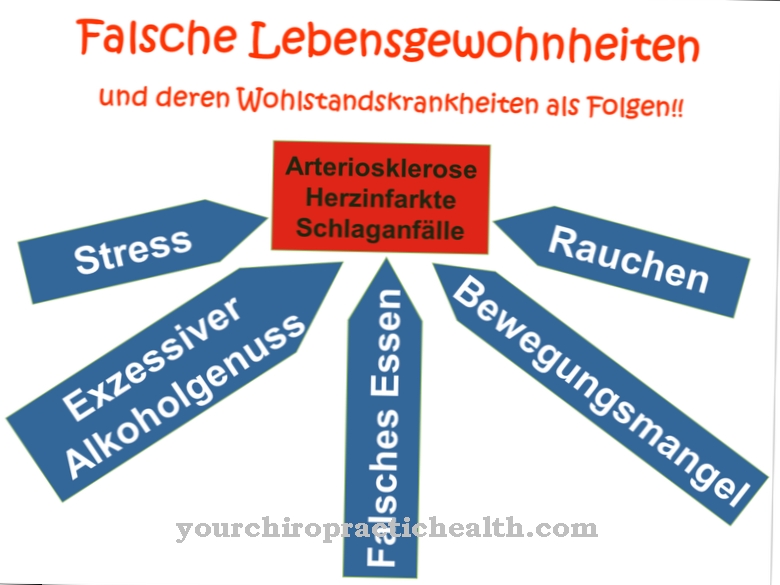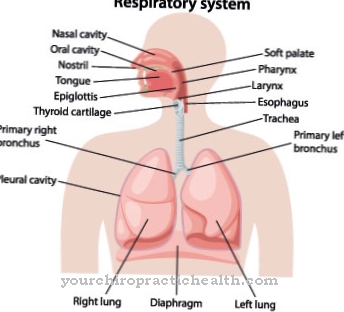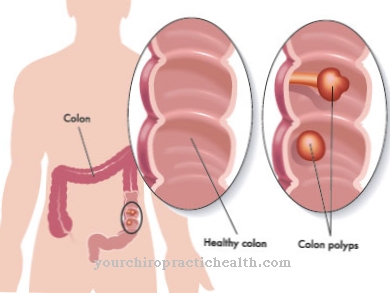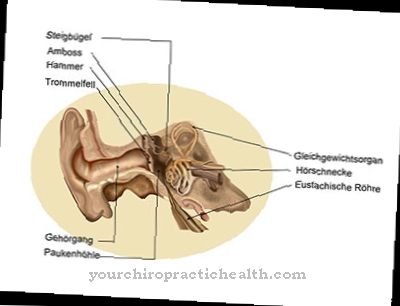The toxic megacolon is a life-threatening complication of various intestinal diseases. The colon expands massively and septic-toxic inflammation occurs.
What is a toxic megacolon?

© Anatomy Insider - stock.adobe.com
The toxic megacolon is defined as acute dilation of the large intestine with clinically noticeable inflammation of the large intestine. Various diseases and in particular diseases of the intestine can be considered as causes.
The exact pathomechanism is not yet known. Patients with a toxic megacolon experience severe pain and high fever. There is a risk of perforation of the intestine with leakage of intestinal contents into the abdominal cavity. Severe bleeding or even shock can result from the toxic megacolon.
causes
The most common cause of the toxic megacolon is ulcerative colitis. It is a chronic inflammatory bowel disease that progresses in phases. The spread is continuous from the anus to the mouth. Ulcers of the upper mucosal layers are typical of the disease. If the inflammation spreads to all layers of the intestinal wall, a toxic megacolon can result.
A toxic megacolon can also develop in Crohn's disease. Crohn's disease also belongs to the group of chronic inflammatory bowel diseases. Here, however, the rear section of the small intestine and the large intestine are preferably affected. The inflammation spreads discontinuously, but penetrates all layers of the mucous membrane.
A toxic megacolon can also be caused by pseudomembranous colitis. This usually occurs after long-term antibiotic therapy. The antibiotics not only kill the pathological bacteria, but also the physiological bacteria of the intestinal flora. This allows antibiotic-resistant strains to multiply. One species of this type is the bacterium Clostridium difficile. The bacteria colonize the entire large intestine and secrete toxins that cause a severe inflammatory reaction.
Rarely, the toxic megacolon is caused by Chagas disease. Chagas disease is caused by the protozoan species Trypanosoma cruzi and is particularly common in South America and the southern United States. Hirschsprung's disease can also result in a toxic megacolon. The congenital disease is accompanied by a change in the neuronal structures of the intestinal wall nervous system.
How these diseases cause a pathological enlargement of the large intestine is not yet clear. Various messenger substances, the so-called inflammation mediators, may cause muscle relaxation, which leads to a widening and bulging of the intestines.
Symptoms, ailments & signs
The main symptom of the toxic megacolon is a distended, painful stomach. The stomach feels hard because of the defensive tension. The fever is very high. One speaks here of a septic temperature. The heart beats very quickly (tachycardia). The severe inflammation leads to an intestinal obstruction. Stool and intestinal binders can no longer pass. The affected person may vomit feces.
An untreated toxic megacolon can go into shock. Multiple organ failure is also conceivable. When the megacolon perforates, intestinal contents pass into the abdominal cavity. Life-threatening inflammation of the abdominal cavity and the peritoneum (peritonitis) occurs.
Diagnosis & course of disease
The diagnosis of the toxic megacolon is made using an X-ray. For this purpose, a so-called empty abdomen is made. A distended colon is visible there. House doors are usually found in the wall of the colon. House doors are bulges in the wall of the colon that segment the colon. The house doors have disappeared from the toxic megacolon. There may be free air in the abdominal cavity.
Due to the severe inflammation, there are more leukocytes in the blood count. So there is leukocytosis. The electrolyte balance is disturbed and anemia may be evident. The sedimentation rate is significantly increased.
Complications
A toxic megacolon is always an emergency and must be treated quickly. If this does not happen, the resulting intestinal obstruction and the accumulation of toxins in the body will lead to the death of the person concerned after a certain time. If left untreated, the damaged thick arm is often perforated, which ultimately releases toxins and other substances into the abdominal cavity.
The result is life-threatening internal sepsis. Shock and multiple organ failure are also possible consequences if the disease is not treated. Furthermore, massive blood loss (due to bloody diarrhea) can lead to a rapid drop in blood pressure.
Treatment in the conservative way can be successful, but it is also possible that there is no improvement within a few days. In such cases, surgical intervention is required. For those affected by the toxic megacolon, this means permanent loss of colon tissue or the entire colon and rectum.
Accordingly, the person affected is then dependent on an artificial anus for life, insofar as a large part of the colon had to be removed. The toxic megacolon itself is a serious complication of inflammatory bowel disease (such as ulcerative colitis or Crohn's disease). All complications in this context can still occur during treatment.
When should you go to the doctor?
Disorders of the gastrointestinal tract, digestion and irregularities when using the toilet should be presented to a doctor. An increased body temperature, a general feeling of illness and malaise indicate an illness. A doctor is needed so that the cause can be clarified.
Palpitations, irregular heartbeats and internal weakness are other complaints that require a doctor's visit. If an intestinal obstruction occurs, a doctor should be consulted immediately. A decrease in normal physical strength, inner restlessness, as well as fatigue and exhaustion are signs of a health disorder.
If the daily obligations can no longer be fulfilled, action is required. Irritability, sleep disorders or other dysfunction should be discussed with a doctor. Vomiting of feces is characteristic of the disease. If this happens, a doctor should be consulted as soon as possible. A life-threatening development can result if medical care is not instituted.
Pain in the stomach or intestines, induration below the chest, and swelling should be examined and treated. Blood loss, a sharp drop in blood pressure and pale skin coloration should be understood as warning signals from the organism. An emergency doctor should be called in acute situations. Without intensive medical care, those affected are at risk of blood poisoning, massive blood loss or damage to the organs.
Therapy & Treatment
The toxic megacolon is acutely life-threatening and therefore an emergency medical emergency. The treatment takes place under constant monitoring of the patient. The main goal is to quickly relieve the strain on the colon and to balance the impaired electrolyte and fluid balance. In addition, the accumulating toxins must be eliminated.
Therapy is usually of a conservative nature. Those affected receive plenty of fluids and broad-spectrum antibiotics. Glucocorticoids are also used. If this does not lead to improvement, leukocyte apheresis (LCAP) can be used. Apheresis is a type of blood wash. The blood is fed into a system through a tube. There, white blood cells such as lymphocytes, granulocytes, monocytes and also platelets are removed from the blood.
Then the filtered blood is returned to the body. This is intended to reduce the inflammation. Ciclosporin A and monoclonal antibodies can also be prescribed. If there is no improvement within 48 to 72 hours, surgical intervention is required. During the operation, the colon and rectum are partially or completely removed. An ileostomy is placed to drain the stool.
The ileostomy is an artificial anus (anus praeter). A deep loop of the small intestine is led out through the abdominal wall in the area of the right lower abdomen. If the large intestine has been completely resected, the ileostoma must be permanently preserved and then serves to discharge the intestinal contents at the end. Double-barreled ileostomas are created temporarily to relieve the inflamed colon. They can be removed after healing.
prevention
The toxic megacolon can only be prevented by early and effective therapy for the underlying disease. The chronic inflammatory bowel diseases are treated with cortisone preparations, immunosuppressants or TNF-alpha blockers. Surgical intervention may be necessary before a toxic megacolon develops.
The pseudomembranous colitis is treated with antibiotics. Another option is a stool transplant. Antiprotozoic drugs are used to treat Chagas disease. Children with Hirschsprung's disease need to be operated on as early as possible. The affected colon segments are removed and the intestine is relieved by an artificial anus before a toxic megacolon develops.
Aftercare
In around 40 percent of all cases of illness, the toxic megacolon leads to the death of the person concerned. The focus of the aftercare is then on survivor therapy. Regular psychotherapeutic treatment is indicated for the first-degree relatives to cope with the grief.
In the remaining 60 percent of cases, the toxic megacolon can be treated conservatively or surgically, depending on the severity and the decision of the specialist. With conservative therapy, the task of follow-up care is to maintain the patient's clinically stabilized and improved condition.
For this purpose, the further course of the disease is closely monitored clinically and radiologically after the clinical stay. In addition, laboratory tests of the blood and stool must be carried out regularly on the person concerned. The measures are intended to prevent the indication for surgery from being carried over.
After an operation on the toxic megacolon, the range of necessary follow-up examinations and treatments is very diverse. Because as a result of the operation, either only the affected section of the large intestine or the entire large intestine can be removed. In addition, an artificial anus is regularly created.
A low-fiber diet and adequate fluid intake are recommended as self-help measures after the surgical treatment. The person affected should also split their regular meals into numerous smaller meals. In this way, the intestine can learn its normal function again as the disease progresses.
You can do that yourself
It is not always advisable to consult a doctor. Sick people can sometimes cure a condition like a cold on their own. Rest and rest help the body to recover. The toxic megacolon, on the other hand, is a serious and life-threatening condition. Self-therapy is excluded in this case.
An operation takes place regularly. Patients with the typical symptoms should seek medical treatment immediately. Self-measures do not promise recovery. A mortality rate of around 50 percent does not allow self-treatment beyond scientific knowledge.
However, there are several things that people can do to help them recover. Above all, relaxation and recovery have a positive effect on healing. Sports activities should be completely stopped immediately after an operation and then only gradually restarted. The attending physician will be happy to advise patients on this.
The diet also needs to be changed. Many small meals are advised. Low fiber foods are preferable. After a treatment, the bowel has to get used to its normal functions again. A sufficient and non-alcoholic fluid intake supports him. The chair can then be transported again.

























.jpg)


